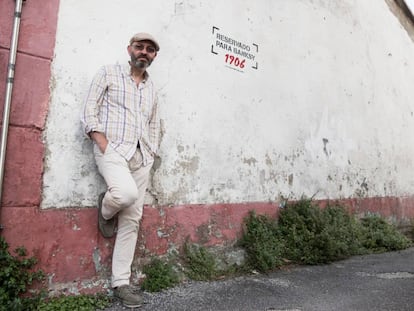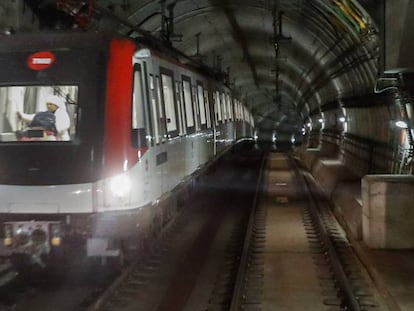Marketer by day, warrior by night: Meet the graffiti artists risking their lives to paint Spain’s trains
They meet up in stations, haunt hidden passageways and ignore no-entry signs. The infrastructure behind cities’ Metro and rail services has become as familiar to them as their own houses. Hooded and fast, they seek out carriages to spray as a cocktail of romanticism, art, adrenaline and risk courses through their veins. They are the ‘guerillas’ and this is their paint war

It is Friday night in the suburbs of Barcelona. In a parking lot near the Torras I Bages Metro station, five men between the ages of 20 and 40 take a crowbar and a 20-meter-long rope from the boot of their BMW. They are wearing sweat pants, dark clothes and trekking boots. The smoke from their cigarettes mixes with the fog from the cold air as they talk about gaps to slip through, radial saws and the police above the hum of the distant highway traffic.
They are graffiti artists – or “writers” as they call themselves – and their goal tonight is to risk their lives painting an old Metro carriage that was built in 1926 and taken out of circulation 30 years ago. “It’s a top model train,” says one as he unravels the rope and ties a number of knots in it.
The old carriage is located inside a facility at the rail junction belonging to Barcelona Metropolitan Transport (TMB), the main public transport operator in Catalonia. “This is a real fort,” says another. “There are cameras everywhere, it’s deep inside and swarming with guards.”
The person talking goes by the name of Jabato. He is one of the most respected graffiti artists in the country with 25 years of experience behind him. The 37-year-old has two children and works as a painter during the day. He has traveled halfway around the world to spray trains and has only recently returned home after spending three months in and out of jail in New York for spraypainting a number of wagons in the city.
Graffiti artists come from all kinds of backgrounds: marginalized, middle class and wealthy
There is also a 40-year-old man in the group, who confesses to having “got hooked” again after more than 10 years without doing it. He is recently divorced, he says, and no one is waiting for him at home. The other men are between 20 and 25; one of them is a student. The others prefer not to speak too much.
According to the National Police and the Catalan regional police force, the Mossos d’Esquadra, around a thousand Spaniards dedicate their free time to sneaking into rail and Metro facilities to spray paint train carriages. It is a closed group that generally avoids media attention. They favor anonymity, lead a double life and compete among themselves in an urban game that revolves around dodging security systems. In most cases, the result of the graffiti is secondary. The real driving force is adventure. Many work a normal job during the day and spend hours during the evenings planning their missions. They check out the guards’ shifts, cover or move security cameras, break sensors, and open up vents and gaps in walls that will allow them to sneak behind the scenes of the country’s Metro and rail systems.
People of all kinds are involved; they may be from marginalized, middle classes or wealthy backgrounds. “Many of them are apparently totally normal: they have jobs, studies, a partner, a family,” says Luz Clemente, the chief inspector of the Central Operative Section of the Mobile Brigade of the national police.
The phenomenon costs the rail operators millions of euros in damages. The numbers are not exact because, besides having to remove the paint, other factors cost money, such as withdrawing targeted carriages from circulation, fixing up damage to facilities and the new coats of paint that have to be applied to the carriages once they have been cleaned.
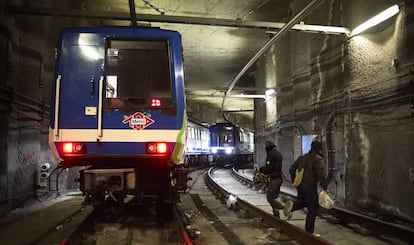
According to the Urban Public Transport Association (ATUC), rail companies spent more than €20 million just in removing graffiti in 2017. But the real cost is likely to be more. Spain’s state railway company, Renfe, puts the clean-up cost in 2017 at €15.7 million. That same year, Madrid Metro spent €1.6 million in removing graffiti, according to data released last November by Europa Press. Also in 2017, TMB said graffiti cost the agency €12 million, though this covered more than just the cost of removal.
All the police, drivers and security guards who were interviewed for this article said that besides the expense, the main problem is the increasing violence of graffiti artists. Last November, in one weekend, groups of 30 and 40 vandals attacked several Metro stations in both Madrid and Barcelona, stopping trains to spray them and clashing with police, guards, passengers and drivers in the process. Several people were injured in the clashes and required medical assistance.
“They are increasingly more violent,” says Ricardo Ortega, head of TMB security, as he checks the 8,000 security cameras that are scattered throughout the Metro system from his control office. “Otherwise, why would they be carrying crowbars and pepper spray, and cover their faces with ski masks?”
According to the Mossos d’Esquadra, of the 3,500 graffiti incidents recorded last year, only seven involved violence. Both the Catalan police and the TMB, however, question this figure, explaining many less-serious incidents are not reported.
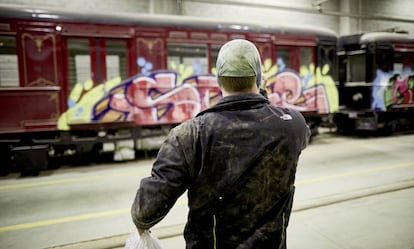
Meanwhile in Barcelona, Jabato and his team prepare for action. They cover their faces to avoid being recognized by the security cameras. None, however, are carrying crowbars or pepper spray. “There’s no point,” says Jabato. “Ninety percent of us run as soon as we are discovered. The problem is the commotion the other 10% make.”
National Police officers, Catalan police and those in charge of security for the TMB agree with what graffiti artists in this report claim: most of them are against violence because it gives them bad press, and those who are violent tend to be young and inexperienced. “Most want to get in, paint and leave without being seen,” says Joaquim Bayarri, superintendent of the Mossos d’Esquadra’s Transport Division. “But for several years now some have been having violent confrontations with the guards.”
After getting inside a construction site and jumping over a number of fences, the graffiti artists reach a Metro vent that will allow them to enter the facility. The access hole is several meters squared and a couple of meters off the ground. But below the grid, there is a six-meter drop. “Fuck, this is really high, man,” says one of the younger ones as he gapes down into the hole.
The vent was cut by a radial saw the day before and they open it and feed in the knotted rope. The plan is to drop down the vent using the rope, but no security harness.
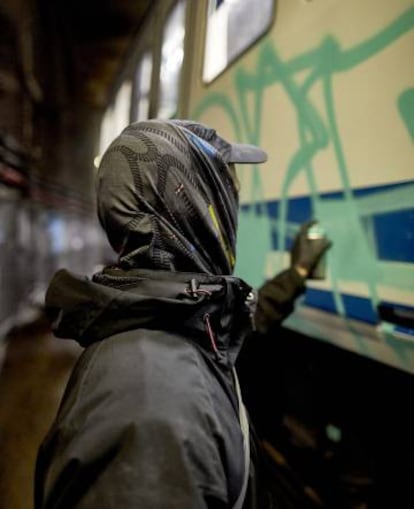
Two of the graffiti artists waver – the youngest and the oldest – and decide not to go down. “It’s too high, you could get killed,” says older man. “I’ll keep an eye out from here.”
Both the graffiti artists and the Mossos d’Esquadra would confirm the danger of the evening’s activities several days later. More than a year ago, a young graffiti warrior fell in this same spot, endning up in a coma. He is still suffering the consequences.
Jabato, however, appears to be fearless. First he goes down to check things out. Then, he climbs back up while the group lights the way with their cellphones. Jabato knows the Metro system like the back of his hand and there is something serpentine about the way he slips through one vent and emerges from another, navigating the maze as though he were in his living room. He has been doing this since 1993 and has no intention of stopping. “It’s my escape route,” he says. “It makes me feel alive despite the problems that go with it. Since I sprayed my first train, I have not sprayed a single wall.”
So why do people risk their lives to spray a train carriage that is not even in use anymore? Tradition, ego and adrenaline appear to be the three main explanations. “Graffiti was born and developed in the 1970s on the New York Metro,” says Jaume Gómez, president of the Spanish Association of Investigators and Disseminators of Graffiti and Urban Art (Indague), who has a doctorate in art history. “That is why painting a carriage is considered the purest and most original form. There is a kind of stock exchange of prestige among those who participate where a value is placed on each of their actions. The riskiest are worth the most.”
There is a quest for adrenaline, for putting yourself at risk José Sánchez, anthropologist
José Sánchez is an anthropologist who is involved in a research project called Transgang at the Pompeu Fabra University. For some time, he has been analyzing graffiti artists and their pursuit of an adrenaline rush. “We live in a totally hedonistic society,” he says. “There’s a continual quest for an adrenaline rush, putting your life at risk to provoke a physical feeling.”
According to Sánchez, graffiti artists have a lot in common with bungee jumpers or motorcyclists who like to ride fast. “In a society that experiences feelings with their eyes, to experience something real that makes your hair stand on end and sends a buzz through your body is very addictive,” he says.
Sánchez adds that the sense of belonging to a group, an element notable in groups such as skinhead or Latino gangs, is another a significant factor. “The graffiti artist is ‘someone’ in their small underground world; they are recognized there, respected and valued,” he explains. “And that, perhaps, is something that does not happen in their real lives.”
One by one, the graffiti artists drop down the vent. Once at the bottom, they are forced to make a 90-degree turn. They start to crawl through the tunnel, inches deep in dust. They drag themselves slowly, nudging the bags of aerosol cans along with their heads. After several meters, they emerge from the vent into a kind of machine room where they stop to put the nozzles on the cans and order the colors.
“As soon as we go in, the cameras are going to see us,” says Jabato to the others. “We paint for 10 minutes and we’re out!”
While he watches the preparations from a half-open door, he calls the man keeping watch outside. “Everything good?” The answer is short. Jabato hangs up and gets ready for his adrenaline rush.
It all happens at the speed of light. A megaphone is triggered as soon as they enter, warning of intruders. The three move quickly toward the target, a train that is unusually black and grey – a museum piece. Each of them gets to work, totally absorbed in what they are doing. No one speaks. Jabato fills his letters with pink, using two hands. The smell from the paint gets stronger. You could cut the tension with a knife. All are aware they could be discovered at any moment. After nine minutes, they are done and photograph their work. Suddenly, Jabato’s phone rings. He checks who is calling but does not answer. Instead, he starts running as fast as he can and the others follow. He opens an emergency exit that leads onto the stairs and they run up them two at a time. They leave by another door that opens onto a bus parking lot, then climb the fence, pick their way across an asbestos roof and climb over another fence that is even higher to leave the facility. The man who was watching out for them says it was a close call. “Just as you came out, three guard cars were coming in really fast.”

It might seem, from what has been in the media in recent months, that graffiti on train carriages is something new. The police authorities, however, explain that the problem goes back to the 1990s. “They have been painting the carriages for more than 20 years,” says Eduardo from the anti-graffiti unit of the National Police’s Mobile Brigade. Together with eight other officers, Eduardo spends his time studying these spray guerillas and their work to see if they can identify them. A certain respect exists between the hunters and the hunted, who are involved in a game of cat and mouse.
“It’s true that there is a certain degree of respect,” says Javi, another anti-graffiti officer. “They see that our work is clean and we are surprised by their knowledge of the rail systems and networks.”
According to TMB, graffiti has tripled since 2000. With regard to long-distance trains, Renfe says that it has doubled in the last 10 years, a piece of data confirmed by the National Police. The data from 2018 suggests that the amount of graffiti has not risen since 2017, which was a bad year for the rail companies. Renfe estimates that there are around 11 graffiti attacks a day. Barcelona Metro claims to have between four and five. In response, special units have been set up within the transport departments to deal with the problem.
Most graffiti artists want to get in, paint and leave without being seen
Superintendent Joaquim Bayarri
Two weeks after the mission in the Barcelona Metro, Jabato travels to Madrid to spray more carriages there. “I’ve painted the Madrid Metro a couple of times but it’s been a while,” he explains as he drives his four-by-four to the capital.
He has arranged to meet Lose, another very respected graffiti artist, who has also been at it for more than 20 years and, like Jabato in Barcelona, knows every nook and cranny of his stamping ground.
Jabato and Lose meet on Monday night at the Manoteras Metro station. A 30-year-old guy and a 25-year-old woman go along with them. The man works in a marketing company and the woman in the hospitality industry. Lose explains that he is currently out of work. They walk to another station and go down to the platform where they wait for the next train. Just as it leaves the station, they jump behind it and start to run as fast as they can along the tracks through the tunnel, guided by the flashlight from their cellphone.
They stop at a small entrance and wait for trains to pass in both directions. Then they start running again. Just before they reach the next station, there is a gap in the wall that takes them to another set of tracks where the carriages are kept when stationary. There is a guard on the platform. They wait until he turns around and sneak through the gap one by one, using the wiring like a tightrope. After jumping another wall, they finally reach the other tracks and sit and wait for the trains to come in.
Is it only the graffiti that has increased or has the level of violence also risen? The authorities claim that both are on the rise and blame social media and light penalties. As far as social media is concerned, many artists nowadays use the internet to boast about their conquests and increase recognition. “Exhibiting on social networks generates a certain ‘call to arms.’ The youngsters discover something they didn’t know about,” says Domingo Corchado, who is in charge of Civil Security and Protection at Renfe.

With thousands of followers on his Instagram account that he recently closed, Jabato agrees. “Before it was just our thing and totally underground… Now it is out in the media and all of society knows about it,” he says.
The use of social networks for graffiti represents a contradiction in terms for Jabato but he recognizes that the comments he receives boost his self-esteem.
With regard to penalties, once the criminal code was reformed in 2015, many of the arrests resulted in no more than an administrative fine. “You can do damage worth €10,000 and get a fine of between €300 and €600,” says Clemente from the National Police. The artists themselves recognize that the size of the fine does nothing to deter them. “Three hundred euros is what it costs to go skiing for the weekend,” says one.
According to the head of the Mossos anti-graffiti unit, this has created a perfect storm for violence – more people joining the gangs because of social networks and the media, lighter fines and more guards. “With more guards, there will obviously be more confrontations with the graffiti artists,” he says.
In order to increase the penalties, the police, the Mossos and the train companies share information on the vandalism and its costs. The idea is to get those arrested charged with crimes for damages, as happened last November when a judge in Barcelona gave a graffiti artist a year behind bars. There was an appeal against the sentence, however, and no definitive ruling has yet been made.
The authorities claims that both the amount of graffiti and violence is on the rise
The graffiti artists in Madrid have noticed an increase in police pressure after what happened in November, but the developments do not overly concern them. “People were inactive for a few days after what happened but then they went out to paint again,” says Lose as he waits for the carriage he aims to graffiti.
After more than two hours, the train finally pulls in. The graffiti artists run toward it and get to work, two on each side. After five minutes, another train comes down the other track and they are discovered. Jabato stands in front of it and waves his arms. The driver sounds the horn. Then the vandals take off through the tunnel and the chase begins. They run until they reach a warehouse. A guard jumps out of nowhere, shouts and runs towards them.
“Calm down, léon! Stay there,” spits Lose. They open the emergency exit that takes them onto the M-11 freeway and the chase continues above ground.
The four graffiti artists cross the highway and split into two groups. Various police cars with blue flashing lights have surrounded the area. The graffiti artists run panting toward a mound close to the highway. Suddenly a guard’s car draws up alongside them. The vandals throw themselves to the ground and wait. A torch lights up the mound, searching, and they hold their breath, praying they are not seen. Their hearts race. The night could quickly turn into a nightmare. But finally the engine starts and the car pulls away. “All the time, I was thinking, ‘As soon as I hear the door, I am going to start running’,” one of them says later.
They come down from the mound, scale the three-meter fence and get onto the train tracks. In order to avoid the police, they walk five kilometers until they are in Piovera. Then they get back on the street and keep to the shadows until a car comes to pick them up. It is 3.50am on a Tuesday morning. The mission started more than five hours before and one of the four says goodnight and peels off. “I’m going to get some sleep. I have a meeting tomorrow morning,” he says.
English version by Heather Galloway.
